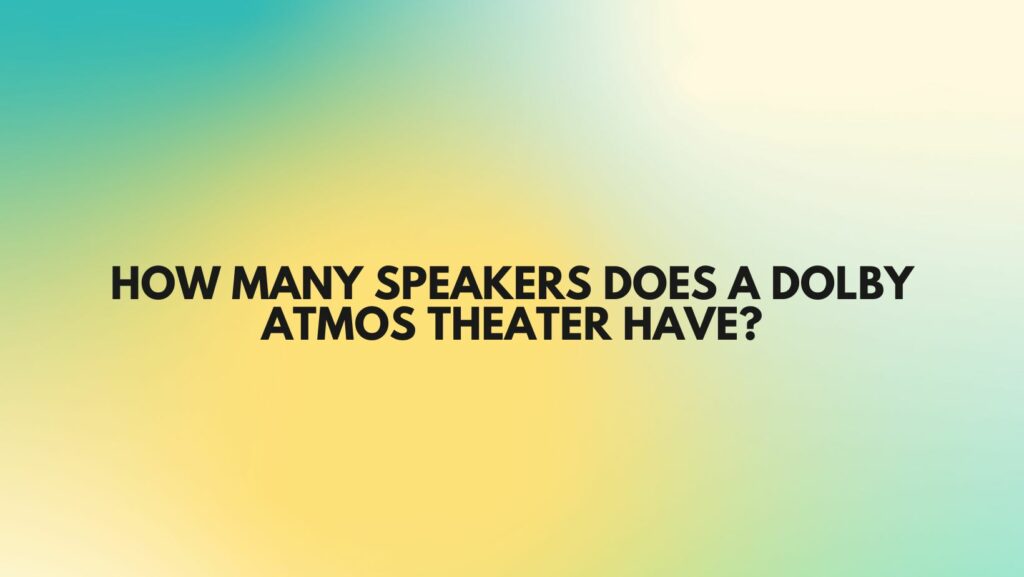Dolby Atmos has become synonymous with a transcendent audio experience, and the heart of this phenomenon lies in the intricate web of speakers that weave a three-dimensional soundscape. For enthusiasts seeking to unravel the mystery of Dolby Atmos theater setups, the question arises: How many speakers does a Dolby Atmos theater have? In this exploration, we dissect the anatomy of a Dolby Atmos theater, unveiling the speaker symphony that brings movies and music to life with unparalleled depth and dimension.
- The Evolution of Dolby Atmos:
Dolby Atmos represents a seismic shift in audio technology, introducing height channels to envelop the listener in a sphere of sound. Unlike traditional surround sound setups, Dolby Atmos theaters boast a configuration that extends beyond the horizontal plane, creating a captivating three-dimensional auditory experience.
- Channeling Audio Precision:
- Traditional Channels: A standard surround sound system typically includes channels for front, center, and rear speakers. Dolby Atmos introduces additional height channels to convey sound from above, enhancing the sense of depth and realism.
- Overhead Channels: The distinguishing feature of a Dolby Atmos theater is the incorporation of overhead channels, which can range from two to a more immersive configuration with additional speakers for a true cinematic experience.
- Common Configurations:
- 5.1.2: This entry-level configuration comprises five traditional speakers (front, center, and rear) and one subwoofer, augmented by two overhead speakers for height channels.
- 7.2.4: A more elaborate setup includes seven traditional speakers, two subwoofers, and four overhead speakers. This configuration provides a heightened level of precision and localization for overhead audio effects.
- 9.2.6: For the ultimate Dolby Atmos immersion, theaters may deploy nine traditional speakers, two subwoofers, and six overhead speakers. This setup delivers an unparalleled depth of sound that captures the nuances of the filmmaker’s audio vision.
- Speaker Placement and Precision:
- Speaker Layout: Dolby Atmos theaters adhere to specific guidelines for speaker placement, ensuring that the entire listening area is enveloped in a seamless auditory experience. Precision in placement is crucial to delivering the intended audio effects.
- Object-Based Audio: Dolby Atmos introduces the concept of object-based audio, allowing sound to move freely around the theater space. This dynamic capability enhances the sense of realism by precisely placing audio elements in three-dimensional space.
- Professional and Home Dolby Atmos Theaters:
- Commercial Theaters: Professional Dolby Atmos theaters found in cinemas often feature a more extensive array of speakers to cater to larger audiences. These configurations may include additional surround and overhead speakers to deliver a cinematic experience on a grand scale.
- Home Theaters: Dolby Atmos configurations for home theaters are designed to be scalable, allowing enthusiasts to tailor the setup to their space and preferences. Whether a 5.1.2 or a more elaborate 9.2.6 configuration, the principles of channeling audio precision and overhead immersion remain constant.
Conclusion:
The number of speakers in a Dolby Atmos theater varies based on the desired level of immersion and the size of the theater. From the entry-level 5.1.2 configuration to the cinematic grandeur of a 9.2.6 setup, the key lies in creating a symphony of speakers that work in harmony to transport the audience into a world where sound knows no boundaries. In the realm of Dolby Atmos, the speaker ensemble is the conductor of an audio orchestra, crafting an immersive sonic masterpiece that redefines the way we experience entertainment.


